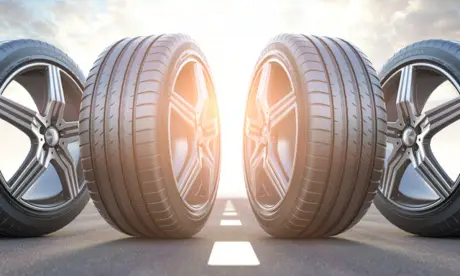
The only part of a vehicle that comes into direct contact with the road is its tires, so the tire must be sturdy, comfortable, and energy-efficient. The design of a tire is much more important than you might think.
Generally, the tires are classified into 2 types, radial, and bias. For a long time, bias tires reigned the roads, but in the 1970s, this trend completely changed with the inception of radial tires. Since that time, Radial tires have been the most popular choice for drivers because of their enhanced build and features.
Radial Tires:
In radial tires or radial-ply tires, plies are placed at a 90-degree angle to the center of the tire. This unique design gives radial tires improved endurance, heat resistance, and flexible sidewalls.
Radial tires are not pure rubber, but multiple materials are embedded with the rubber. For example, like a combination of concrete and steel, these rooted materials make tires more robust. Some of the materials used in radial tires are steel belts, Polyester, Kevlar, etc.
Radial tires have two layers where the first or outer layer has steel belts implanted in rubber. This outer layer is known as Tread. The second layer is composed of rubber-coated steel plies. Positioning and angle of plies are what make the real difference. In radial tires, the plies run radially around the tire from its center, due to which the footprint is shorter but wider.
Here are some unique features of radial tires
- Radial tires boast improved durability and a longer lifetime because of their construction.
- Increased stiffness in the radial tire is because of the steel belt layer.
- These tires have thick shoulders to protect the interior.
- Another layer of protection for the interior of the tire is its flexible sidewall.
- These tires handle heat very well with the help of a chafer.
Bias Tires:
A bias tire or diagonal tire has layers of fabric plies embedded in the rubber, which are arranged at an angle of 40 degrees with another consecutive layer of plies positioned at the opposite direction of the first layer to create a crisscross pattern. This distinctive design offers a comfortable ride on rough roads, gives more control, and withstands heavier loads. But cons outweigh the pros by a considerable margin, such as these tires are prone to overheating, provide almost no to very low grips, and decrease the fuel efficiency.
Advantages of Radial Tires:
- Radial tires are much more reliable and give a sense of security to the people by offering solid gripping power.
- The bead filler system in radial tires improves handling and makes the vehicle easy to maneuver.
- The unique radial ply across the beads spreads the load symmetrically through the tires and makes the rides more comfortable.
- Another plus is the protection of the interior from damage due to thick and strong shoulders.
- Radial tires enhance fuel efficiency and noise control by reducing rolling resistance.
- These tires have great resistance to heat, so they generally have a longer lifetime and are more durable.
- Radial tires reduce vibrations and increase stability.
Same articles

Understanding Vehicle Inspection and Verification Services: Why They Matter for Every Driver
GuidesVehicle inspection and verification services are an essential but often overlooked part of keeping roads safe and cars legally compliant. Most people only think about inspections when it’s...
KLIFEX Brand Overview: High-Quality Automotive Repair Kits for Affordable Repairs
GuidesThe automotive aftermarket has long needed solutions that combine reliability, durability, and affordability. Many car enthusiasts and services are looking for a way...
Fast, Reliable Vehicle Emissions & Inspection Services Made Simple
GuidesFast, reliable emissions and inspection services are essential for keeping vehicles road-ready, compliant with environmental regulations, and safe for daily driving. If you’re looking for quick...

